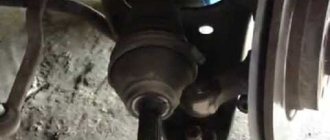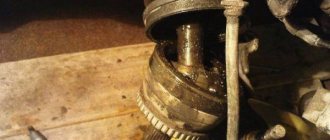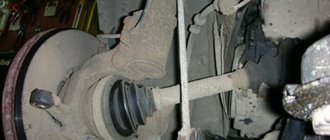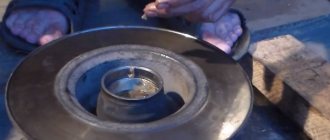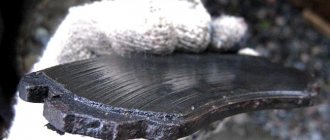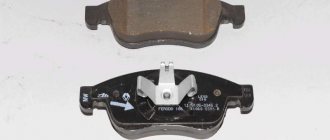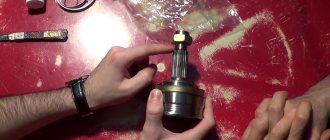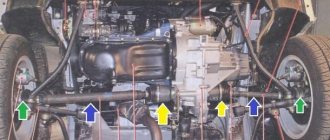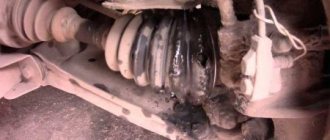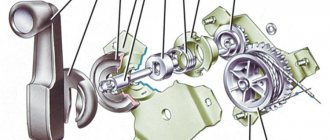Basic malfunctions of the Chevy drive grenade
There are 4 main signs that the constant velocity joint needs to be replaced or repaired:
- A crunching sound when driving slowly when turning, which intensifies as the wheel angle increases.
- Knocks or crunching sounds during a sharp (or not so sharp) start.
- Play in the hinge. It can be determined by shaking the axle shaft with your hands.
- Jerks when accelerating the car.
Malfunctions of CV joints occur as a result of manufacturing defects, incorrect installation of a part, lack of lubrication, driving at high speed over potholes, or natural wear of rubbing parts.
Important! Internal and external constant velocity joints wear out especially quickly when the boot is damaged. In this case, lubricant leaks from the CV joint, and instead the bearings are filled with abrasive particles of sand and dirt.
Checking the hinges is carried out in three stages:
- Turn the steering wheel completely and try to move away slowly. If a crunching sound is heard, it is necessary to change the “grenade”. In this case, the sound comes from the side where there is a problem.
- Raise the car on a lift or hang out the wheel from which you can hear a crunching sound. Visually check the integrity of the boot and make sure there is no play by shaking the axle shaft with force by hand.
- Raise both wheels of the front axle and engage reverse gear. A crunch indicates the need to replace the grenades.
If a breakdown is detected, the parts must be replaced with new ones.
Auto parts for foreign cars, auto repair
We also disconnect the universal joint fork from the flange of the front axle drive shaft of the transfer case. Remove the front driveshaft. Having disconnected the hinge forks of the rear propeller shaft from the flanges of the rear axle gearbox and the drive shaft of the rear axle of the transfer case, remove the rear propeller shaft. Don’t forget to note its position relative to the flanges of the transfer case and rear axle gearbox.
Install the shafts, aligning the previously applied marks, in the reverse order of removal. The article is missing: Checking the serviceability of the cardan transmission In order to reduce the fuel consumption of the Shnivy Niva Chevrolet how to remove the front cardan, you only need to check the functionality with the PP box in neutral gear.
The car is driven onto an overpass or inspection hole and shoes are placed under the wheels so that the car can move, but does not roll off the overpass. Let's start testing. The inspection is carried out for both types of structures: External inspection. All joints are inspected to see if the bolts are loose, and what condition the boot is in.
Next, both hands grasp the shaft on the side where the connections are checked, and with sharp movements, how to remove the front driveshaft is carried out. If there is a slight backlash, then the design is faulty.
There shouldn't be any play. With sharp movements it is necessary to rotate the shaft around its axis of rotation, while holding the hinge fork-flange with one hand. There should be no circumferential gaps. When does a device need to be replaced?
When the design of the device, so to speak, loses the balancing of the plates, or all parts of the product are replaced, then upon completion it is imperative to re-balance the driveshaft. If, after balancing, the problems with the product malfunction are not eliminated, then the shaft assembly is replaced with all elements.
Balancing the cardan is done either by visiting a service station, where specialists will perform all the related work, or independently, which will save money. But that is another story. Removing and replacing a driveshaft Removing and then replacing a Chevrolet Niva, how to remove the front driveshaft on a Chevrolet Niva up to a year old, is carried out in the following order: The vehicle is installed on an overpass.
At the gearbox, the lever is placed in neutral and the parking brake is in position. Shoes are installed under the wheels for safety. Before removal, it is necessary to make notches on the ends of the flanges, drive axle and transfer case at the joints. This will help return the shaft to its original position without the need for balancing. The nut of the cardan bracket is unscrewed, while supporting the bolt so that it does not rotate.
Replacing the front driveshaft on CV joints on a Chevrolet Niva video
All fastening nuts are unscrewed in the same way. There are four of them on one side.
The nuts are Teflon coated to prevent self-turning. After removal, even if the shaft is not replaced, it is recommended to replace the nuts with new ones. Three fastening bolts are removed from one side, and the fourth is left to fix the product in its original position. We carry out the operations of unscrewing the nuts on the other side of the fastening. The order of unscrewing does not matter.
The last bolt is removed from one side and the cardan is removed, while its parts are reduced to the slot. The product has been removed, it is now being repaired, and if this is not possible, it is being replaced with a new one.
The installation procedure is the reverse of removal. First of all, how to remove the front driveshaft from a Chevrolet Niva car to neutral and the parking brake to position.
A stop is placed under the transfer case, which can be adjusted. The nuts securing the side brackets of the transfer case suspension and the two rear mounting nuts are unscrewed. The box is lowered until it comes off the bracket studs. The cardan is rotated and the nuts securing the shaft to the drive axle flange are unscrewed and removed.
To unscrew the nuts, you will need to install a special blade in the hole between the flange and the CV joint. After this, the CV joint is pressed out with this blade until it moves slightly from the shaft splines and, thus, allows the nuts to be unscrewed.
Removing and installing the Chevrolet Niva driveshaft
Now, using two blades, you need to press the CV joint until the fastening studs come out of the slots in the drive axle flange. The transfer case, which has been removed from the studs, will allow this manipulation to be performed. If you do not remove the transfer case, then the free play of the connection of the splines of both CV joints will be too small.
We replace the outer and inner ones on a VAZ 2123 with our own hands
Hinges tend to wear evenly.
Useful! Therefore, it is better to change the left and right CV joints at the same time.
Before starting work, you need to prepare the appropriate tool:
- wheel wrench;
- screwdriver;
- jack;
- hammer;
- extension;
- vice;
- support under the bottom of the car;
- keys for 13, 17, 27.
First you need to dismantle the drive, and then change the internal and external hinges. Work order:
- unscrew the fastening nuts and disconnect the cardan from the front axle;
- lift the car, hang it up and remove the front wheels;
- unscrew the lower shock absorber mounts from the levers;
- unscrew the nuts holding the bearing housings of the internal constant velocity joints;
- Unscrew the gearbox fastening to the cross member. Raise the knot and secure it by tying or placing a support.
Further actions are performed sequentially for the left and right drives.
- remove the cap protecting the wheel bearing;
- unscrew the nut;
- remove the bushing;
- raise the lower arm by compressing the suspension spring;
- unscrew the fastenings of the lower ball joint;
- move the steering knuckle to the side, releasing the splines of the outer CV joint;
- unscrew the exhaust pipe from the exhaust manifold and move it to the side (this operation is only needed to replace the right-hand drive CV joints);
- move the gearbox back a little;
- pull out the drive.
Next, you need to replace the hinges with new ones. To do this you will have to disconnect them from the drives. This is done like this:
- clamp the axle in a vice;.
- dismantle the old boot;
- using an extension, knock the CV joint off the axle splines;
- clean teeth from dirt;
- put on a new hinge;
- lubricate the part;
- put on a new boot and secure it with a clamp.
Then all that remains is to assemble the drive. Parts are installed in the reverse order of removal. Related articles:
However, the problem is that in order to timely detect a defect in the boot, it is necessary to conduct a thorough inspection of it every day. This is difficult to do under normal conditions.
Repair: disassembly and lubrication
You can do without replacement if damage to the boot was detected in time. In this case, the “grenade” bearings may not have time to collapse due to the ingress of water and sand.
Important! The repair consists of disassembling the CV joint and thoroughly washing it in kerosene. After this, you need to put new grease into the bearings and put on a new cover.
However, the problem is that in order to timely detect a defect in the boot, it is necessary to conduct a thorough inspection of it every day. This is difficult to do under normal conditions.
Useful video
Watch a visual video below on how you can replace the CV joint on a Chevrolet Niva with your own hands:
When changing the angle of rotation of the drive drive on the Chevrolet Niva, the transmission of rotating torque from the engine to the wheels is carried out with the participation of a special unit - a constant velocity joint (in the future, possibly a CV joint). What is a part, what types exist for this car brand, what are the operating rules? The answers to these and other questions are contained in the material presented. Also here you will find a description of the instructions for replacing the internal CV joint on a Chevrolet Niva yourself.
Symptoms of a problem
The main malfunction of the drive on the Niva is the appearance of play inside the CV joint or tripod. As they wear out, the balls erase the surface of the inside of the glass and make indentations, inside of which they then begin to dangle.
Often, a torn boot, which allows dirt and moisture inside, accelerates the wear process. They wash out the lubricant and scrape along the surface of the working parts.
Malfunctions of grenades on Niva appear as follows:
- The appearance of significant play in the transmission when starting or shifting.
- A crunch when starting with the wheels turned out is a sign of a malfunction of the external grenade on the Niva.
- A hinge knock or vibration during acceleration is a sign of the development of internal grenades or tripoids.
If these malfunctions are present, it is recommended to drive into the inspection hole and grab the drive with your hands. Rock them in a vertical plane. If play is felt inside the glasses, then the CV joint is worn out. Axial play when turning the drive is normal. The main thing is that it is not too big.
What is a node
The name CV joint itself is an abbreviation for the phrase constant velocity joint.
The node faces the following tasks:
- Make the transmission of rotating torque from the engine to the wheels of the drive drive uniform and without loss of power.
- Reduce the load on expensive parts that rotate to move the car: shaft, gear, etc.
- Reducing the level of vibration when moving vehicles.
Modern front-wheel drive cars and some all-wheel drive “horses” are equipped with such homokinetic joints. The manufacturer guarantees the same duration of operation of the unit and the vehicle itself, provided that the CV joint is serviced and driven carefully. That is, if you drive carefully and periodically properly care for the part, it will last for the entire life of the vehicle.
The fulfillment of the first point depends only on the personality of the owner, his desire to monitor the technical and sanitary condition of the car. But the implementation of the second point on most domestic roads is sometimes simply impossible. And sooner or later the grenade (another name for the unit, which arose due to its external resemblance to a military projectile) fails. It is necessary to replace the internal or external CV joint on a Chevrolet Niva or on another car with a front-wheel drive and all-wheel drive design solution.
How to change a grenade in a field - Auto workshop online
string(10) "error stat"string(10) "error stat"
Drivers did not know what a constant velocity joint, or CV joint for short, was until front-wheel drive cars began to conquer the market. After all, the wheels must turn, but this is impossible to do with the help of a cardan transmission.
CV joints (popularly called “grenades”) are also found on cars with all-wheel drive today—the Russian Niva 2121 is no exception in this sense. If you take care of the hinges and change the anthers on time, the factory-assembled unit can last more than 100 thousand km (it all depends on operating conditions).
But sooner or later the X-hour comes, and replacing the CV joint on the Niva becomes inevitable. The process is not easy, including choosing a node in the store. But more about everything.
Replacing the inner and outer CV joints on Niva 2121
It is impossible to transmit torque to the front wheels with one joint, so there are always two of them. One is internal, the other is external. The first unit, located next to the gearbox, experiences the greatest load. Compared to the external one, it is larger in size, because The CV joint on the wheel is limited in size due to the small free space.
CV joint device VAZ 2121
Both hinges include fundamentally the same elements, differing only in size and cost.
Main parts:
- cup-shaped housing with driven shaft;
- “fist” in the shape of a sphere with a drive shaft, forming a CV joint cage;
- steel balls located in special grooves of the holder and made of special types of metal.
When it is necessary to make a turn, the angles of both shafts change, the balls move along the grooves and transmit physical force to the wheels of the front axle. Usually a “Rtseppa” (“six-ball”) hinge is used.
It cannot transmit torque from the gearbox on its own: for this, a shaft is used - a hollow steel pipe connecting the outer CV joint with the inner one. The latter operates continuously at a rotation angle of 10 degrees. The external unit operates in the same way, provided the movement is smooth.
But as soon as the wheels turn, the angle at the outer joint increases to sixty degrees.
If the car moves on an uneven road, the distance from the outer unit to the inner one changes, so the shaft is mounted in such a way that it can either move in or out.
How to remove the drive
Failure to replace the hinge in a timely manner will lead to disastrous consequences: in the worst case, the drive may jam, which at high speed can lead to an emergency situation. Therefore, it is more advisable to replace the unit in a timely manner. How to change the CV joint on a Niva? It is best to remove everything assembled; for this you will need:
- socket head wrench for 13 and 27 with a wrench (preferably a ratchet type);
- extension to the wrench in the form of a hollow pipe;
- hammer;
- flat screwdriver (you may also need a chisel);
- a jack and a wheel wrench for removing the wheel.
Inner CV joint
Place the car on a viewing hole, and, if possible, on a lift. In the first case, you will need a jack. But first you need to remove the hub nut cap with a screwdriver and loosen it, then remove the wheel and unscrew it completely.
Further steps to replace the grenade on the Niva:
- Using a 13mm socket, unscrew the nuts securing the ball joint to the steering knuckle.
- Using a jack, smoothly lower the lower arm onto a suitable wooden block.
- Remove the shaft from the hub by moving the steering knuckle up and back (secure it with wire), and removing the retaining ring to remove the outer joint.
- Remove the 3 pressure plate nuts securing the inner CV joint. Pry it up with a flathead screwdriver and pull the internal assembly out of the gearbox.
- If it is inconvenient to remove the hinge when assembled, disconnect it.
Below see how to remove the CV joint on a Niva21213 - video.
How to replace a grenade
When you have the inner grenade in your hands, collect the bearing balls if they have fallen out and put them in a container with kerosene. Remove the retaining ring from the shaft that holds the cage and the separator. Take a drift and, hitting it with a hammer, knock down the hinge, hitting the end of the cage. Remove the retaining ring and thrust ring. Clean all removed parts with a metal brush and rinse in kerosene.
Disassembling the hinge
How to put it in place
Reassembly begins with lubricating the shaft and installing the anthers in their original places. Next, the reverse locking rings are installed - it is better to do this in a vice. The next step is to install the hinge on the shaft: feel for the splines and lower it until it comes into contact with the ring located outside. Now, through the wooden spacer, hit the CV joint with a hammer so that it snaps into place. Move the part in different directions to make sure it is securely fixed. All that remains is to install the anthers with clamps.
Installation of the unit is carried out in the reverse order of removal. In this case, it is recommended to use screw clamps rather than standard ones. The hub nut needs to be installed with a new one. At the final stage, do not forget to use it to adjust the clearance in the bearings.
Varieties
SR as a suspension part began to be used on cars from the mid-20th century. Thanks to the unit, it became possible to simultaneously rotate and control the rotation of the wheels at an angle of up to 70 degrees. In the automotive industry, four technical solutions for components are used:
- cam;
- tripoid;
- ball;
- twin cardan shafts.
All these types are united by the basic design, which is a rigidly connected body and holder. The car's joints are also divided into:
- internal, rotating up to 20 degrees;
- external, more mobile and transmitting without power losses.
The part works according to the following principle.
- There are grooves on the surface of the inner race. Their number is the same as the number of bearings inside it.
- The cage is held in place by bearings that separate the housing and the cam.
- The bearings move along the path of the smaller diameter of the fist and the larger diameter of the housing.
- This creates a rotational impulse that transmits torque to the driven shaft.
If you change the angles connecting the axle shafts, the bearings begin to move inside the grooves. This is how torque is transmitted.
Reasons why a hinge joint fails
The internal CV joint on a Chevrolet Niva is a high-quality and reliable part of the automobile chassis system. Listed below are the main reasons that provoke early wear and failure of the unit.
- Incorrect, illiterate, extreme (rapid start with inversion of the drive drive and slipping) driving.
- Lack of care for a part that needs periodic cleaning and lubrication.
- Unfair production of the hinge assembly using low-quality materials and violation of technological rules.
Several signs listed below indicate that there may be a problem with the grenade and the internal CV joint on the Chevrolet Niva needs to be replaced.
- The appearance of a crunching sound when making turns. This phenomenon occurs if the SR requires lubrication of the connections, or a mechanical inclusion, for example, dirt, gets into it.
- Interruptions in the movement of the car at the start, when the speed increases or, conversely, when it decreases.
- Increased vibration when turning, accelerating, or driving at high speeds.
To make a final diagnosis, auto mechanics have created several simple techniques.
Why does a grenade break?
Sometimes it is necessary to replace the inner CV joint on a Chevrolet Niva. In order to reduce the likelihood of breakdown, you need to know what reasons lead to this. Specialists and experienced car owners identify the following reasons under the influence of which the “grenade” will require replacement or repair:
Despite the fact that the Chevrolet Niva is an SUV, it is necessary to ensure that difficult road conditions are not constant. The reasons for the “grenade” to fail include dirt, dust or large particles getting into the components.
According to the statistics of requests, in 90% of cases the outer part of the element requires replacement. To reduce the likelihood of an emergency, it is recommended to regularly check the condition of the protective rubber covers and adjust the fastening in the unit.
Diagnostics
Experienced mechanics advise car owners to pay attention to the condition of the boots approximately every 5-7 thousand kilometers. Detection of any defects: cracks, failure of the clamp, indicates that the CV joint may be damaged. How can I check this?
- The car is placed on a lifting mechanism and engaged in first gear. A worn-out assembly will produce a sound resembling a characteristic crunching sound.
- An increase in play of one and a half tens of mm is a characteristic sign of failure. They check it by pumping the internal CV joint of the Chevrolet Niva at the output of the external drive.
You need to check the performance of the part periodically, every 4-5 months of driving on good roads. And every time after driving over rough terrain, dirt roads, potholes, etc.
Caring for front wheel joints
It just so happens that most motorists pay attention to some part of the car after it breaks down. A new CV joint is purchased and replaced, which takes time and considerable money.
In fact, there is no drift to the angular velocity hinges installed in the Niva.
Unlike front-wheel drive VAZ 2110-2114 cars, in the Niva the torque is distributed over 4 wheels. This means that the load on the front wheel drive is half as much as in the same VAZ 2114. And if we theoretically assume that not a drop of abrasive dust and dirt gets inside the hinge mechanisms of the axle shafts, then the service life of the CV joint will be equal to the “life” of the CV joint itself. auto. Of course, this is impossible in real life, and the Niva is designed for off-road driving.
It is quite possible to prolong the life of grenades as much as possible. To do this, you must regularly perform the following activities:
- Conduct a visual inspection of the anthers covering the hinges. When the car is operated on an asphalt road, an inspection should be carried out every 10-15 thousand km. When driving off-road or on embankment and dirt roads, the grenade cases need to be inspected more often, especially after driving in difficult conditions.
- If the slightest damage to the boot is detected, immediately replace it with a new one. This also applies to the clamps that hold the covers in place.
- During replacement, remove old grease from the Niva CV joint along with any dirt that has fallen into it and apply new one. The lubricant used is CV joint-4, its quantity for the outer grenade is 40 cm3, for the inner grenade - 80 cm3.
If you pay attention to these elements, they will easily last 150-200 thousand km
Otherwise, malfunctions may appear within the first hundred thousand km.
Replacing the internal CV joint of a Niva Chevrolet
All parts of the unit are in constant motion during operation, as a result of which they wear out and fail. Therefore, most car owners are faced with the need to replace a faulty internal CV joint of a Chevrolet Niva with a serviceable one. Below is material for the step-by-step implementation of this work.
- The front of the car must be in an upright position. To ensure safety, it is necessary to place protective devices under it to ensure the immobility of the mechanism.
- At the very beginning you need to remove the wheel and the lower ball joint.
- Next, disconnect the shock absorber and the lower arm on the suspension, from which the spring is removed.
- The fist and hub are not removed, it is slightly hung to the side. To do this, you can adapt a generator belt or something similar.
- Then the cap and bearing nut are removed from the hub.
- The bolt that secures the right suspension bracket is unscrewed.
- At the assembly itself, you need to unscrew the nut and remove the grower, freeing up access to a larger threaded length. Using keys and a hammer, the SR is dismantled, removing it from the hub.
The hinge assembly on a Chevrolet is mounted in the reverse order.
A grenade on a car is a constant velocity joint. The knot received this name because it looks like a military knot. It can also be called CV joint. With its help, torque is transmitted from the engine to the wheel in a car at different angles of rotation of the drive wheel.
Removal and installation of front wheel drives Niva Chevrolet
You will need: keys “13”, “17”, “27”, a wrench for the wheel nuts.
1. Disconnect the front driveshaft from the front axle gearbox (see “Removing and installing the driveshaft”).
2. Raise the car and remove the front wheels.
3. Disconnect the shock absorbers from the lower front suspension arms.
The hub nut is tightened to a large torque. Therefore, we recommend using a head with a strong knob.
16. Remove the left drive in the same way.
You can watch the video: Removing the drive
17. Install the drives and all removed parts in the reverse order of removal.
When tightening the wheel hub nuts, adjust the play in the bearings (see “Checking and adjusting the play in the front wheel hub bearings”).
CV joint on Niva Chevrolet
With its help, torque is transmitted from the engine to the drive wheels. It's mostly front-wheel drive. Due to the CV joint, torque is transmitted uniformly, taking into account the fact that the wheel is at a different angle relative to the car.
On a Chevrolet, a grenade can be:
- Internal.
- Outdoor.
Outer CV joint Inner CV joint
Like all other parts in the car, this unit has its own specific service life. Therefore, every Niva owner sooner or later is faced with the need to replace the CV joint.
Reasons for grenade failure
One of the reasons for the failure of the CV joint is a breakthrough of the boot and the ingress of dirt.
The CV joint can fail for the following reasons:
- Long service life of the mechanism . This is the most common cause of breakdown. Usually the part has to be replaced after 10,000 kilometers (on average), but it may happen that repairs are required even earlier.
- Sloppy driving . This could be sharp turns, driving on an uneven road at high speed, or turning the steering wheel when the car suddenly starts. In all these cases, the maximum load is placed on the CV joint.
- Water, dust or dirt gets into the device . For this reason, the hinge may also fail prematurely. Water gets inside due to damage to the rubber boot. The protection can crack due to any factors during operation, so it is recommended to periodically check its condition.
What is a CV joint (grenade)
Internal grenade on Shniva
This part appeared at a time when manufacturers began producing cars with front-wheel drive. Initially, torque was transmitted to the drive wheel using a conventional cardan . At the same time, the service life of the hinge was short, since it was constantly working under load. This problem gave impetus to the invention of a special unit (CV joint), which could transmit torque to the wheels at different angles of rotation.
Grenade replacement
Right inner CV joint close up, you can see the article number and markings
This unit consists of parts that are constantly in motion. As a result, they may burst or wear out , requiring replacement.
The device can only be repaired if the owner of the car has identified damage to the boot in time, and therefore foreign substances have not yet managed to get inside the mechanism.
But this happens quite rarely, since it is almost impossible to detect damage to the boot in time. It should also be said that the cost of the CV joint is not high, and therefore it can be purchased if necessary.
Video about restoring the Niva Chevrolet CV joint
Troubleshooting
You can determine the malfunction of the grenade yourself . To do this, while the car is moving, turn the steering wheel in any direction until it stops. In this case, the driver will hear a crunching sound in the area of the front wheel. In this case, you need to replace the hinge.
During the repair process, it is important to determine whether it is necessary to change both hinges or one, because such work is recommended to be carried out only in a comprehensive manner.
Video on how to determine if a grenade is faulty
Changing a grenade on a Niva Chevrolet with your own hands
To replace a grenade, you must first remove the old one. In the process, you will have to dismantle the axle shaft along with the CV joint (you can find a disassembly video on the Internet). Then the car owner must perform the following actions:
- Clamp the removed assembly in a vice.
- Remove the old boot.
Removing the boot - Knock the CV joint off the axle using a hammer and a socket.
We knock down the CV joint - Clean all teeth on the axle gear.
- Install the new joint on the axle.
Installing a new hinge - Place the boot and secure it with clamps.
Installing the boot - Install the axle with CV joint on the car.
Install the axle with CV joint on the car in the reverse order
Video about replacing a grenade on a Niva Chevrolet using a reverse hammer
Chevrolet Niva GLC › Logbook › Replacing the right inner and outer CV joints. Change of shoes for the summer
The right inner CV joint often clicks when turning. And after the turn, until you let off the gas. And when climbing a steep mountain through the forest, it also clicks constantly. It's time to change it, and at the same time the external one for prevention. I installed the factory anthers again and did not buy Trek. The drive stick is original from the factory, I don’t change it either.
lift the gearbox to remove the inner CV joint
An attempt to remove the drive assembly failed. The ear of the bearing cover is in the way. I disassembled the inner CV joint by pulling out the retaining ring.
After 40 minutes we managed to pull out the inner part of the inner CV joint!
Divide and conquer
Replaced the oil seal (with Felix sealant)
Separated the new CV joint
Assembled the interior
Now we put it in place
I installed a new cardboard gasket, having pre-oiled it. Without sealant.
This is how I moved the gearbox. This is the left (driver's) side ear
And in this position of the gearbox, the right inner CV joint enters and exits!
Of course, the RPM shovel was first unscrewed from the stabilizer. And I also unscrewed the stub from the side members, because the cardan rests on it
Conclusion
Knowing the features of the CV joint and how you can identify its malfunction or replace it, you can cope with such work on your own , having little experience in this work.
Replacing the outer CV joint on a Chevrolet Niva is an important undertaking, because if the breakdown is not repaired in time, the consequences can be very sad; the wire may simply jam while driving. One of the first symptoms of this problem is a slight cracking sound when the steering wheel is in the turned position at the beginning of the journey.
Signs and manifestations of malfunction
To carry out timely repairs, you need to pay attention to signs of malfunction. If problems arise with the CV joint, the driver may encounter the following symptoms:
If problems arise with the CV joint, the driver may encounter the following symptoms:
- a characteristic unpleasant, sharp sound appears when turning the steering wheel;
- the sound occurs when reversing;
- slight crunching sound when turning the leading front ears;
- increased crunching and sharp sounds while moving.
The part will need to be completely replaced if shocks occur in the transmission. Slipping also indicates the need for urgent repairs. If the Niva is often used for transportation, how does four-wheel drive work, what maintenance procedure should be found out in advance.
Part Features
Constant velocity joints - these elements were created specifically for front-wheel drive vehicles; previously, torque was transmitted to the wheels using a simple cardan. Due to the large load on the hinge, the service life of the part was very short. To avoid such a situation, this node was created.
An outer CV joint is needed to transmit torque evenly when the wheel is at different angles. CV joints can be both external and internal.
There are certain parts in the assembly that are constantly moving, so often the parts burst or completely wear out, and this requires their urgent replacement. Repair of the device is carried out when damage to the boot is detected in time, when dirt, dust and other substances do not have time to penetrate inside the grenade.
To identify a breakdown on a Niva, turn the steering wheel all the way in any direction while driving. If there is a problem, then you will hear a characteristic creaking sound in the area of the front wheel. During the repair work, you should determine how many hinges need to be changed - one or two at once. Professionals advise implementing the procedure comprehensively.
Disassembling the axle shaft
To access the inner CV joint, it is necessary to carry out the following disassembly operations:
- Remove the grenade boot clamps and remove the inner CV joint boot .
- Knock the CV joint off the drive shaft.
- To remove the inside of the hinge, you need to remove the retaining ring of its cage.
If, when removing the inner CV joint , chips were found in the boot, and there is any damage on the hinge, then replacing the inner grenade is simply necessary.
Before putting the boot on the new inner
CV joint, it is necessary to fill it with special CV joint grease -4 (quantity 150 cm). Replacing the outer and inner CV joints on a VAZ 2110, VAZ. To ensure that there is enough lubricant in the grenade, it is recommended to stuff lubricants under the boot.
Work on replacing the outer CV joint
To carry out the procedure, you must first remove the old grenade, which is removed along with the axle shaft. To do this, you need to raise the body using a jack and install a strong stand under the car to avoid health problems. Before raising the Niva body, it is best to lower the hub nut; for this, a head is used, as well as an extension for the key. After this, the wheel is removed and the lower wheel of the front shock absorber is unscrewed, the nut on the hub is removed, and the grenade is thus pulled out.
After this, replacing the CV joint on a Chevrolet Niva is carried out according to the following steps:
- It is necessary to clamp the assembly that you removed in a vice.
- Removing the damaged boot.
- Knocking down the outer CV joint using a hammer.
- All teeth on the axle gear should be thoroughly cleaned.
- A new hinge is being installed.
- The boot is inserted, which should be clamped using clamps.
- All parts are mounted in place.
To carry out independent repairs, use two heads, an extension, a hammer, a jack, a wheel wrench, a wrench, a ratchet, and a flat-head screwdriver.
Replacement procedure: step-by-step algorithm
There is no point in repairing a worn-out unit, so the outer CV joint of a Niva Chevrolet is always replaced. Replacing a damaged “grenade” is a labor-intensive operation. You will need a set of wrenches, pullers, and experience in performing plumbing work.
Outer CV joint
The damaged unit is replaced using an axle shaft with grenades removed from the vehicle. The body is raised with a car jack, a reliable stand under the car and wheel chocks are installed. This helps protect the repairman from possible injuries. Before lifting the car body, loosen the hub nut. You will need a head and an extension for the key. Next, you need to remove the wheel and unscrew the lower mount of the front shock absorber. Take it to the side and secure it with improvised means. Also unscrew the bolts on the ball joint.
